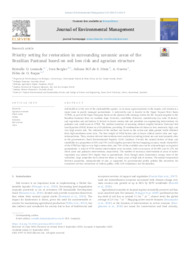Priority setting for restoration in surrounding savannic areas of the Brazilian Pantanal based on soil loss risk and agrarian structure.
Priority setting for restoration in surrounding savannic areas of the Brazilian Pantanal based on soil loss risk and agrarian structure.
Autoria: LOUZADA, R. O.; BERGIER, I.; DINIZ, J. M. F. de S.; GUERRA, A.; ROQUE, F. de O.
Resumo: ABSTRACT. Soil health is at the core of the sustainability agenda. As in many agroecosystems in the tropics, soil erosion is a major issue in poorly managed pasturelands. A noteworthy case is located in the Upper Taquari River Basin (UTRB), as part of the Upper Paraguay Basin on the plateau with drainage waters for the Taquari megafan in the Brazilian Pantanal. Here we combine slope (S-factor), erodibility (E-factor), rainfall-rainy day ratio (R-factor), and vegetation and soil indices (C-factor) to locate erosion risk and prioritize eco-engineering interventions via palisades and small dams in UTRB. The method consisted of assessing distinct weights between Universal Soil Loss Equation (USLE) factors in a GIS platform, providing 35 combinations of classes as low, moderate, high, and very high erosive risk. The validation of the method was based on the ravine and plain ground truths obtained from high-resolution raster data. The best weight of USLE factors aids to locate critical erosive sites and vegetation patterns. Then, erosion risk and interventions were analyzed according to land use and rural property sizes in the government's Rural Environmental Registry (CAR) database. Overall, the natural factors of slope and erodibility in a proportion of 25% and 75% in GIS algebra provided the best mapping accuracy result. About 65% of the UTRB has high or very high erosion risks, and 70% of the available area can be acknowledged as degraded pasturelands. A total of 4744 erosion interventions were recorded, with an accuracy of 65.28% and 61.15% for check dams and palisades interventions, respectively. The number of necessary interventions in areas of native vegetation was almost 50% higher than in pasturelands. Even though micro landowners occupy most of the watershed, large properties have about ten times as many areas at high risk of erosion. The mutual cooperation between properties, independently of size, is supported by governmental public policies like incentives for ecosystem services restoration of critical gullies, with CAR compliance and fiscalization.
Ano de publicação: 2022
Tipo de publicação: Artigo de periódico
Unidade: Embrapa Pantanal
Palavras-chave: Agrarian structure, Barrancos, Check dams, Erosão do Solo, Estrutura Agrária, Gullies, Palisades, Paliçadas, Soil erosion, USLE
Observações
1 - Por padrão são exibidas publicações dos últimos 20 anos. Para encontrar publicações mais antigas, configure o filtro ano de publicação, colocando o ano a partir do qual você deseja encontrar publicações. O filtro está na coluna da esquerda na busca acima.
2 - Para ler algumas publicações da Embrapa (apenas as que estão em formato ePub), é necessário ter, no celular ou computador, um desses softwares gratuitos. Sistemas Android: Google Play Livros; IOS: iBooks; Windows e Linux: software Calibre.
Acesse outras publicações
Acesse a Base de Dados da Pesquisa Agropecuária (BDPA) para consultar o acervo completo das bibliotecas da Embrapa.

